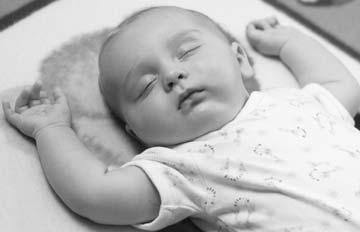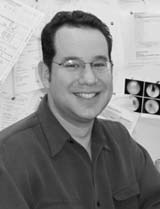The MUHC reaches out for children's health

The professionals in the division of Pediatric Respiratory Medicine at The Montreal Children's Hospital of the McGill University Health Centre (MUHC) are no strangers to reaching out. Using email and electronic stethoscopes, and venturing into the communities that turn to the MUHC for care, they orchestrate programs for children with apnea or on home ventilation, carry out prophylactic treatment of tuberculosis program and run the province's only pediatric sleep laboratory.
Some of these outreach programs were started over 25 years ago, but recent advances in technology have helped many of the programs to reach further and allow the doctor-patient visits to span hundreds of kilometres.
"They don't have to send the babies to Montreal. Isn't that great? I love it," says Dr. Aurore Côté with a smile on her face. Instead of meeting patients face-to-face, Côté, who is the director of the Apnea and Remote Recording unit, spends a good deal of her time consulting by telephone and email, and evaluating and interpreting data on newborns' breathing heartbeat and oxygen levels sent from distant hospitals. "Babies stay where they are born - with their mothers - they're not transferred here. It has really worked extremely well," she says. The arrangement means both parents and physicians are happy that patients are receiving top-notch care close to home.
Côté has also set up in 2004 a pilot program to monitor the oxygen levels of infants with apnea at home - the first in North America. She provides parents with the newest oxygen monitors and teaches the parents how to set up the equipment and respond to the alarms, allowing the babies to live at home, rather than in the hospital for a couple of months. The program has expanded rapidly and Côté's team is working closely with companies that make monitors and software to improve their performance in the home environment.
In addition, Côté does on-site visits to outlying centres, home visits, and teaches at McGill University. She was named to the Faculty Honour List for Excellence in Medical Education in 2003, thanks in large part to her efforts to disseminate information and expertise province-wide. Her work on the clinical science of apnea and breathing control problems and how to care best for newborns and infants, even in remote places, is highly noted.
At the far end of the technology spectrum, Dr. Michael Davis, the former medical director of the Inhalation Therapy and Pediatric Home Ventilation program, deals with patients that require sophisticated machines to stay alive. "These technology dependant children ... are difficult to move around, so instead of them coming to me, I'm going to them - but virtually, not in reality," he says.
Cost is one of the reasons Davis advocates virtual medicine. "If I brought one of my ventilator patients from Chicoutimi, it's $14,000: airfare, transport, escort....We had to try and bring down our costs," he says. Time and resources are another. The pediatric program, run in conjunction with the Montreal Chest Institute of the MUHC and Saint Justine Hospital, covers the entire province.
"As doctors become more and more scarce healthcare commodities - and they are - then you can't afford to have that down-time for traveling and you've got to come up with some effective alternative." He had.
From his lab at The Children's, Davis visited patients throughout the province. He saw them and they saw him through the use of a portable laptop equipped with camera and monitoring technology. And what would a doctor be without his stethoscope? Davis had an electronic one that works with the machines, so that he couldnot only talk to the patients and monitor their vital signs, but also listen to their chests at the same time.
His team monitored 26 to 28 children on home ventilators within the province. Among them were six children who have had a breathing pacemaker implanted, which stimulates regular breathing and allows them to lead a fairly normal life. "Twenty five years ago they all died, now they are...on a ventilator at night and on a pacemaker during the day."
Davis stresses that not all of his work involved high-tech devices; much has to do with preventative diagnostics for kids who are at risk. "Pulmonary function tests should be done at least once a year-it's not an exotic test."
 Respirologist Dr. Mark Anselmo (pictured) and Dr. Larry Lands, the director of the Respirology division, coordinate the Tuberculosis Prophylaxis Program that tests high-risk children for TB infection. |
Looking 30 to 40 years into the future, the Tuberculosis Prophylaxis Program is an example of how preventative medicine can have a huge impact. Dr. Mark Anselmo, a respirologist, and Dr. Larry Lands, the division director, both work in this program. As explained by Anselmo, they use a targeted strategy to find patients who have the disease, but show no symptoms, also called a latent infection.
The program sends out trained professionals to test high-risk children for TB infection. They treat 600 to 800 patients a year on their field trips. "It's easier treating a child for nine months orally now, as opposed to having a potentially infectious adult when they're forty," says Anselmo.
Anselmo is quick to note that, although the infection is present in the children they diagnose, they have not developed the disease, nor are they contagious. The disease can remain dormant for many years, but if left untreated can have serious consequences at a later age. "It avoids us having to treat severe TB 30 to 40 years from now," says Anselmo.
Anselmo says the program is very successful, much of which he credits to the front line nurses. "Our nurses are spectacular. That's our biggest strength right now," he says.
The same can be said of the staff at the Sleep Laboratory of the Jeremy Rill Centre for Respiratory Control Disorders. (The only pediatric sleep laboratory in Quebec.) Here, sleepless nights are the norm, for the staff anyway, as they monitor infants and children from dusk to dawn.
"There are hundreds of kids who snore and have difficulty breathing at night that need an evaluation," says Dr. Robert Brouillette, the lab's director. In children, sleep apnea can often be treated with a tonsillectomy and adenoidectomy.
Whenever possible, the Sleep Lab performs tests in the child's home. "You really want to try to mimic - as much as possible - a normal night for this child," says Christine McGregor, the lab assistant chief respiratory therapist Their efforts mean the readings reflect the normal breathing and sleeping patterns of the child.
"The trick there is to find an efficient way to make the diagnosis," says Brouillette. And that's what they are doing through the Oximetry Program. The parents pick up the machines and test their children at home, then bring back the data. Brouillette then has the information analyzed by computer, reducing both technician and physician time.
"We're trying very much to have a comfort zone for the children," says McGregor when explaining how the Sleep Laboratory functions. It's safe to say that due, in part, to the outreach programs at the MCH, the comfort zone is continually growing.
- Peter Biedlingmaier
